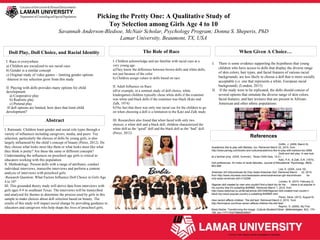
Factors Influencing Doll Choice in Girls
- 1. Picking the Pretty One: A Qualitative Study of Toy Selection among Girls Age 4 to 10 Savannah Anderson-Bledsoe, McNair Scholar, Psychology Program; Donna S. Sheperis, PhD Lamar University, Beaumont, TX, USA I. Rationale: Children learn gender and social role types through a variety of influences including caregivers, media, and peers. Toy selection, particularly the choices of dolls by young girls, is also largely influenced by the child’s concept of beauty (Perez, 2012). Do they choose what looks most like them or what looks most like what they think is pretty? Are these the same or different concepts? Understanding the influences on preschool age girls is critical to educators working with this population. II. Methodology: Present dolls with a range of attributes; conduct individual interviews, transcribe interviews and perform a content analysis of interviews with preschool girls. -Research Question: What Factors Influence Doll Choice in Girls Age 4 to 10? III. This grounded theory study will derive data from interviews with girls ages #-# in southeast Texas. The interviews will be transcribed and analyzed for themes to determine the process used by girls in this sample to make choices about doll selection based on beauty. The results of this study will impact social change by providing guidance to educators and caregivers who help shape the lives of preschool girls. References I. Race is everywhere a) Children are socialized to see racial cues b) Gender is a similar concept c) Original study of video games – limiting gender options -Interest in toy selection grew from this study II. Playing with dolls provides many options for child development a) Cooperative play b) Realistic play c) Pretend play -If doll options are limited, how does that limit child development? Abstract Griffin, J. (2009, March 9). Academics like to play with Barbies, too. Retrieved March 22, 2015, from http://www.psmag.com/books-and-culture/academics-like-to-play-with-barbies-too-3898. Dolls and doll play: A new look at a familiar prop. (2004, Summer). Texas Child Care, 12-21. Katz, P.A., & Zalk, S.R. (1974). Doll preferences: An index of racial attitudes. Journal of Educational Psychology, 66(5), 663-668. Lee, E. (2004, June 16). American Girl Discontinues Its Only Asian-American Doll. Retrieved March 22, 2015, from http://www.nbcnews.com/news/asian-america/american-girl-discontinues- its- only-asian-american-doll-n132266 London, B. (2015, February 2). Nigerian doll created by man who couldn't find a black toy for his niece is so popular in his country that it's outselling BARBIE. Retrieved March 1, 2015, from http://www.dailymail.co.uk/femail/article-2931846/Nigerian-doll-created-man-couldn-t- black-toy-niece-popular-country-s-outselling-BARBIE.html Perez, Alicia. (2012, August 6). How racism affects children: The doll test. Retrieved March 2, 2015, from http://feminspire.com/how-racism-affects-children-the-doll-test/ Raynor, S. (2009). My First Black Barbie: Transforming the Image. Cultural Studies/Critical Methodologies, 9(2), 179- 185. doi:1177/1532708608326607 I. There is some evidence supporting the hypothesis that young children who have access to dolls that display the diverse range of skin colors, hair types, and facial features of various racial backgrounds, are less likely to choose a doll that is more socially acceptable (i.e. one that represents a white, European racial background). (London, 2015) II. If the study were to be replicated, the dolls should consist of several options that simulate the diverse range of skin colors, facial features, and hair textures that are present in African- American and other ethnic populations. I. Children acknowledge and are familiar with racial cues at a very young age. a)They know the difference between brown dolls and white dolls, not just because of the color b) Children assign values to dolls based on race II. Adult Influence on Race a)For example, in a seminal study of doll choice, white kindergarten children typically chose white dolls if the examiner was white and black dolls if the examiner was black (Katz and Zalk, 1974) b)The fact that there was only one racial cue for the children to go on when choosing a doll is a limitation to the Katz and Zalk study III. Researchers also found that when faced with only two choices, a white doll and a black doll, children characterized the white doll as the “good” doll and the black doll as the “bad” doll. (Perez, 2012) Doll Play, Doll Choice, and Racial Identity The Role of Race When Given A Choice…